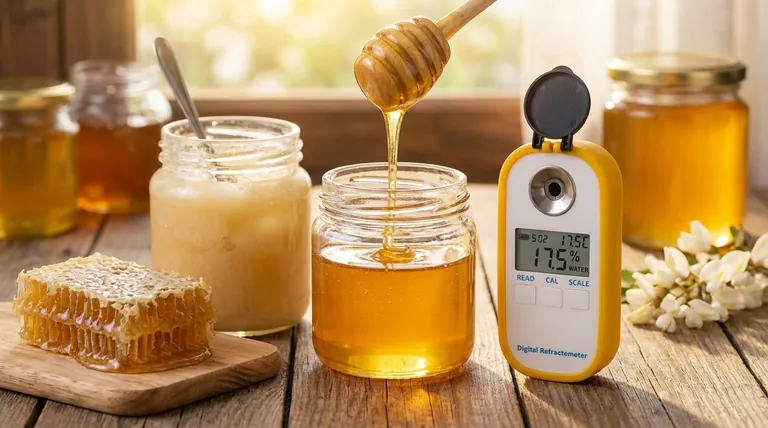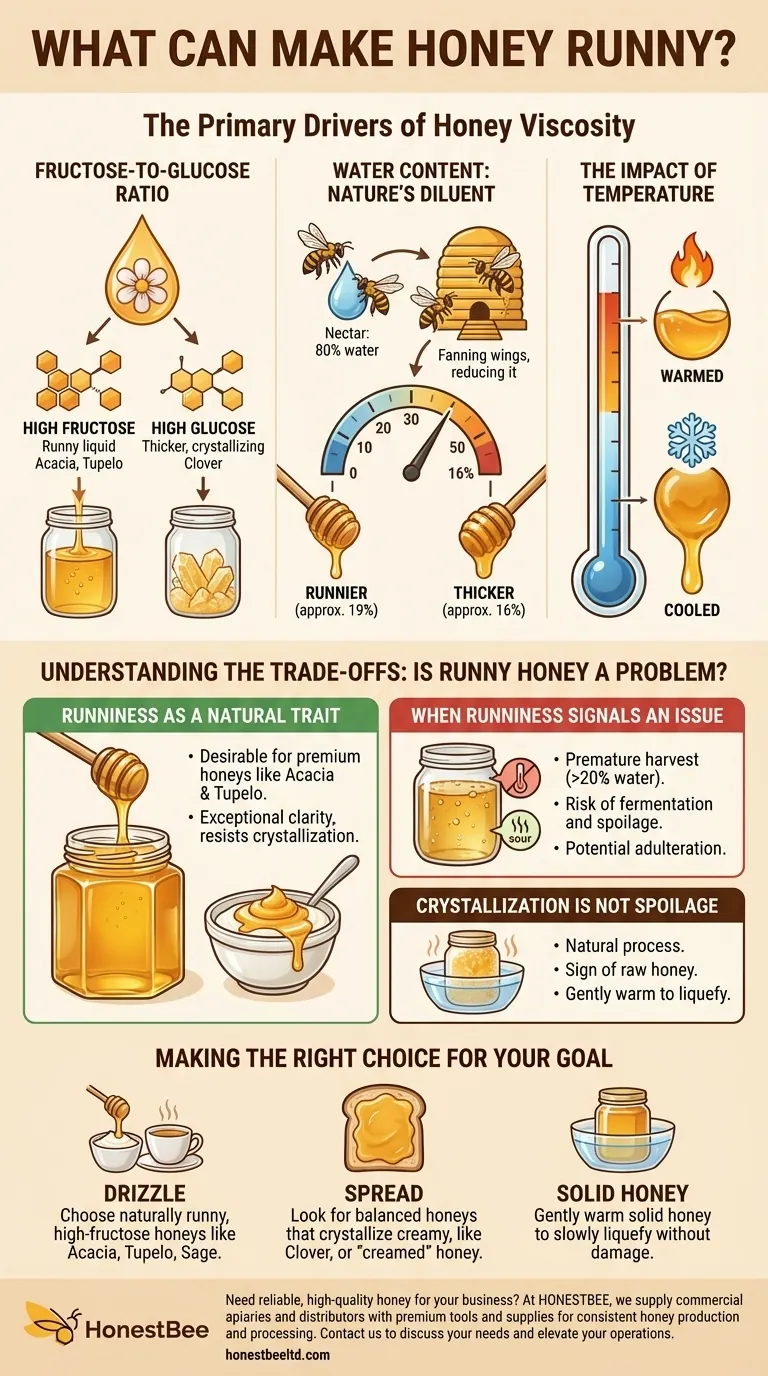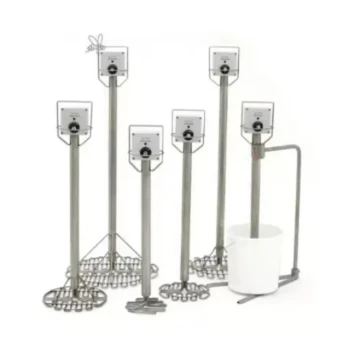The consistency of any given honey is primarily determined by its specific ratio of fructose to glucose sugars and its water content. Honeys with a higher concentration of fructose, like acacia, are naturally more fluid and resist crystallization. Conversely, honeys with higher levels of glucose will be thicker and crystallize more readily.
While temperature and water content play significant roles, the fundamental reason one type of honey is runny and another is thick lies in the unique sugar profile of the floral nectar collected by the bees.

The Primary Drivers of Honey Viscosity
Honey's thickness, or viscosity, is not a random trait. It is a direct result of its chemical makeup and its immediate environment. Three main factors are at play.
The Fructose-to-Glucose Ratio
The two primary sugars in honey are fructose and glucose. Their balance is the single most important factor in determining honey's natural state.
Nectar from each flower species has a unique sugar profile. Honey made from nectar with a high fructose-to-glucose ratio will be runny and remain liquid for a long time. Fructose is more soluble in water than glucose, which keeps it from solidifying.
Conversely, honey with a higher concentration of glucose is prone to crystallization. Glucose is less soluble and readily forms crystals, causing the honey to thicken and eventually become solid. This is why clover honey, for example, tends to crystallize much faster than acacia honey.
Water Content: Nature's Diluent
After collecting nectar, which is about 80% water, bees work to dehydrate it. They do this by passing it from bee to bee and fanning their wings at the hive entrance to create airflow, evaporating moisture until the water content is below 20%.
The final water content directly impacts viscosity. Honey with a water content closer to 19% will be noticeably runnier than a very thick honey with a water content of 16%.
The Impact of Temperature
Temperature has a simple and direct effect on honey's consistency.
When honey is warmed, its molecules move faster and the bonds between them weaken, causing its viscosity to decrease. The honey becomes more fluid and flows easily.
When honey is cooled, its molecules slow down, and it becomes significantly thicker and more difficult to pour. This is a temporary physical change, not a chemical one.
Understanding the Trade-offs: Is Runny Honey a Problem?
A honey's consistency is often misinterpreted as a sign of its quality. In reality, it is usually just a reflection of its origin and state.
Runniness as a Natural Trait
For many premium honeys, being runny is a desirable and natural characteristic. Acacia and Tupelo honeys are prized for their exceptional clarity and liquid-gold consistency, which they maintain due to their high fructose content.
This makes them ideal for drizzling over foods without overpowering them or needing to be warmed.
When Runniness Signals an Issue
Extremely runny, watery honey can sometimes indicate a problem. If honey is harvested prematurely, before the bees have had a chance to reduce the water content below 20%, it can be unstable.
This excess moisture can allow naturally occurring yeasts to ferment the sugars, leading to spoilage. Fermenting honey will often have a slightly sour or "off" smell. Runniness can also be a sign of adulteration with water or syrups.
Crystallization is Not Spoilage
On the other end of the spectrum, many consumers mistakenly believe that crystallized or solid honey has gone bad.
Crystallization is a completely natural process and is actually a sign that the honey is raw and unprocessed. It simply means the glucose has begun to separate out of the liquid solution. You can easily return it to a liquid state by gently warming the jar.
Making the Right Choice for Your Goal
Understanding why honey's consistency varies allows you to choose the right type for your specific need and manage it properly.
- If your primary focus is a drizzle for yogurt, tea, or desserts: Choose naturally runny, high-fructose honeys like acacia, tupelo, or sage.
- If your primary focus is a spread for toast or bread: Look for honeys with a balanced sugar profile that crystallize into a creamy texture, such as clover, or purchase a "creamed" honey.
- If your raw honey has become solid: Gently place the jar in a bowl of warm (not boiling) water to slowly liquefy it without damaging its beneficial properties.
By understanding the interplay of sugar, water, and heat, you can appreciate the unique character of every honey.
Summary Table:
| Factor | Effect on Honey Viscosity | Example Honey Types |
|---|---|---|
| High Fructose-to-Glucose Ratio | Makes honey runny and slow to crystallize. | Acacia, Tupelo, Sage |
| High Glucose Content | Makes honey thick and prone to crystallization. | Clover, Wildflower |
| High Water Content (>18%) | Results in a runnier, less viscous honey. | (Often indicates premature harvesting) |
| Warm Temperatures | Temporarily thins honey, making it more fluid. | (Applies to any honey type) |
| Cool Temperatures | Temporarily thickens honey, making it more solid. | (Applies to any honey type) |
Need reliable, high-quality honey for your business?
Understanding honey's unique properties is key to product quality and customer satisfaction. At HONESTBEE, we supply commercial apiaries and beekeeping equipment distributors with the premium supplies and equipment needed to produce, harvest, and process honey consistently and efficiently.
Whether you need to manage viscosity for a specific product line or ensure optimal harvesting conditions, our wholesale-focused operations provide the tools for success.
Contact HONESTBEE today to discuss your supply needs and elevate your beekeeping operations.
Visual Guide

Related Products
- Digital Honey Refractometer for Precision Measurement of Optimal Honey Quality
- Precision Honey Refractometer Instrument for Quality Assessment
- Natural Wood Honey Dipper for Tea Coffee and Desserts
- 10L Stainless Steel Electric Honey Press Machine
- Easy Use Manual Stainless Steel Honey Press for Honey Comb
People Also Ask
- How is honey applied to the refractometer? Ensure Accurate Moisture Content Measurement
- Do hobbyist beekeepers need a honey refractometer? Ensure Your Honey Harvest Is Perfectly Preserved
- Why is temperature important when using a honey refractometer? Ensure Accurate Moisture Readings
- What is the importance of a honey refractometer for beekeepers? Ensure Honey Quality & Prevent Fermentation
- What is the purpose of a honey refractometer? Ensure Quality and Prevent Honey Spoilage



















